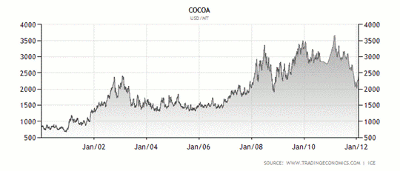A massive supply shift in the world’s top cocoa-producing nation could cause a tremendous reversal in price to begin as soon as the second quarter of 2012, predicts commodities expert Andy Waldock.
The cocoa market spent much of 2011 struggling with leadership issues in the Ivory Coast, which is responsible for approximately 35% of the world’s production. The political turmoil forced end-line users to guarantee their supply regardless of the price so the stores would stay full of M&M’s and Hershey bars.
Opposite the political instability was a bounty of Mother Nature’s 2011 production, which was the highest on record. This led to the largest carryover stocks on record, as well as end-line users hoarding their purchases to protect their production supply. The resolution of the Ivory Coast’s political issues sent the market tumbling by more than a third in the fourth quarter as the market’s attention shifted to the excess supply.
Here’s a long-term chart of cocoa futures:
The political shift in the Ivory Coast from dictator to a freely elected President with the full support of the United Nations is opening up the gates of first world farming technology as well as foreign direct investment. This combination will increase Ivorian cocoa yields dramatically as their farmers adopt new technology to replace the decades-old traditional farming methods that have decreased their production to less than 40% of what some experts believe is their optimum level.
We’ve reviewed the turbulent past and pointed a finger towards a more productive future, but we trade in the present. The present in the Ivory Coast is a state of flux. There are great hopes in the new democracy for farming reforms that will increase the standard of living for more than 700,000 cocoa farmers.
The outside world is also placing a great deal of pressure on the new government to adopt certain price controls to stabilize prices at the ports. Meanwhile, the crop that is currently coming to harvest is caught somewhere in the middle of weather uncertainty.
Weather concerns early this year have impacted the crop substantially. Many are suggesting that last year’s excess production will be quickly consumed, as this crop is expected to be at least 10% less than last year’s.
Furthermore, Western agronomy practices and foreign investment have not yet had time to take hold and mitigate the damage caused by a late la nina dry season.
Finally, the new government is still finding its footing in implementing its reforms. The recent implementation of a daily cocoa auction system is the latest result of the government’s disjointed approach to their chief export. The auctions are supposed to feature daily sales of cocoa at the ports to establish a fixed price that includes transportation from the field to the port. The producers were unhappy with the floor prices and therefore boycotted the auction, leaving the government organizers to entertain the corporate buyers for the afternoon at the auction site.
This recent exportation hiccup along with the diminishing size of this year’s crop has provided enough concern to get the market up about 5% off of the January lows. The consolidation pattern that’s been forming over the last three weeks may prove to be the key to the near-term direction of this market. A move back above $2,350 per ton would most likely force a large speculative short position to begin taking profits. This buying could provide significant fuel to the emerging rally, as the speculative short position is one of the largest on record in this market.
The Ivory Coast is developing a modern government and agricultural infrastructure very rapidly. This process will help ensure consistent, high-quality supply in the same way that the US provides so much of the world’s grains. Therefore, a rally through the end of the second quarter may be the final hurrah for one of the most volatile commodity markets.
By Andy Waldock of Commodity & Derivative Advisors






















